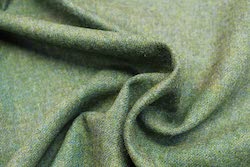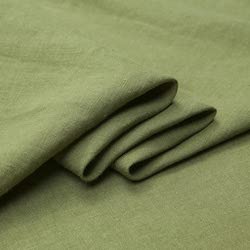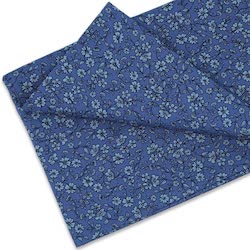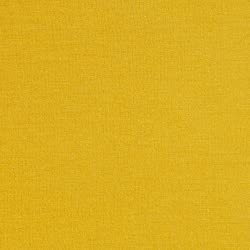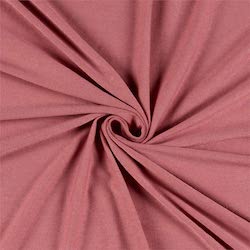The kimono is a type of traditional Japanese clothing with a long and rich history. Traditional kimonos, which have many layers of fabrics and a complicated structure, are still worn today during special occasions.
As fashion evolves and the kimono is adapted to everyday wear, it is now a light layering piece for the summer. Thanks to their lightweight structure and soft fabric, kimonos can also be super comfortable as loungewear.
The most popular fabric for kimonos are silk, wool, linen, cotton, rayon, polyester, or even polyester blends.
If you are hoping to incorporate a kimono into your wardrobe, read on to find out more about this garment and pick the best fabric for your kimono.
Brief History of the Kimono
In Japanese, “kimono” used to be the word for clothing. The Japanese kimonos that we know today were actually developed during the Heian period (794 – 1185).
The kimono is constructed by cutting strips of fabric and then sewing them together, only adding a collar to create structure. With this technique, the kimono doesn’t have to be tailored to each individual’s measurements.
When the piece is worn, the clothing is draped over the wearer’s body and then tied at the waist with an obi (a long sash). Traditional kimono are often worn in several layers, giving them a structured look.
Typically made from lightweight and breathable fabric like silk (summer) or wool (winter), kimono can be comfortably worn in layers without being too stuffy.
As modern life takes over, people no longer find the traditional kimono practical or convenient. Today, Japanese people are still wearing traditional kimonos, but only during special events and festivals.
Kimonos in Fashion
Nowadays, the traditional kimono design has been adopted and modified by Western fashion. Many Western designers draw inspiration from these traditional designs.
The kimono-inspired garments we see in fashion today are similar to traditional, true kimonos in terms of construction and material. They are quite loose-fitting, with a defined collar. They can sometimes come with a fabric belt to tie everything together.
These kimono-inspired garments include luxurious robes and other pretty lounge ware, breezy cardigans, or even dresses.
We also see a lot of traditional kimono materials being used to make these lightweight, everyday clothing. Materials like silk or linen are still quite popular in making true kimono and kimono-like clothes.
In the following section, we will use the word “kimono” mostly to refer to the light, flowy layering piece that we can wear every day, whether as a fashionable cardigan or as a comfortable loungewear piece.
If you want to learn about traditional kimono, you can learn more from Japan Zone here.
What Fabrics Are Used For Kimonos/Kimono-Like Garments?
Since kimonos used to be worn in several layers, they had to be made out of lightweight and breathable materials so that they wouldn’t cause too much discomfort for the wearer.
Moreover, kimono fabrics should be soft and smooth. Since modern kimonos are quite loose-fitting, the fabric often drapes while having some structure so that it would complement the wearer’s body. Of course, as an outer layer, the fabric needs to be fairly durable as well.
Silk is the first obvious choice when it comes to making a kimono – and the traditional Japanese kimono are often made from silk as well. For more affordable fabric options, you can also consider synthetic or semi-synthetic substitutes like polyester or rayon.
Although not many people think of wool when mentioning kimono, this is a great material for kimonos as well. Since kimonos have traditionally been an outer layer, using a lightweight type of wool would transform a copycat into a cozy garment for colder days.
For the summer, when you need something more breathable and sweat-absorbent, materials like linen or cotton are also acceptable for kimonos.
Let’s find out more about each of these materials.
Silk
Both traditional Japanese kimono and modern kimonos love to use silk. It is a beautifully luxurious fabric that is so worth the investment.
Silk is so soft, smooth, and cool to the touch. It reflects light, so you will always look high-class when wearing a silk garment. As a natural fabric, it is very kind to the skin, preventing you from getting irritations.
Silk drapes beautifully and can feel quite airy and breathable when worn. Don’t be fooled by its look; silk is quite a durable fabric that can withstand the wear and tear of everyday use. Silk doesn’t crease easily, so you will always look fashionable when wearing a silk garment.
Keep in mind that silk is a bit difficult to sew, especially if you are new to sewing. Since the fabric is very soft and smooth, it can be a bit slippery when you sew. We only recommend this material if you are confident with your sewing skills. Otherwise, it is very easy to damage this expensive material.
The only minus point about silk is that it is notoriously difficult to care for. You have to handle the silk correctly so that it will stay new.
Silk can bleed, so if you have to wash it at home, keep it separate from your other clothing. However, most people recommend dry cleaning your silk clothing to keep it nice and new.
If you need to iron your silk, the safest bet would be to steam it to remove the wrinkles. If not, you should use low heat with your iron to avoid damaging the silk.
When storing your silk, you should fold it neatly and store it in a dry and cool place, as heat and sunlight can damage the silk. Many people even store their silk clothing in a dust bag so that the silk will stay new for longer.
For stunning silk, we adore this aptly named “blue jewel” silk fabric from TPOHH. The luxurious quality of silk speaks for itself and with such a vibrant color, you’ll feel like royalty. This silk is begging to be made into a house robe.
Wool
Wool kimonos are actually quite popular in Japan as everyday wear, especially during the winter.
If you are looking for a light outerwear fabric, you can use wool for your kimono. Since traditional kimonos are worn in all types of weather, wool has also been a beloved kimono fabric. Winter kimonos usually have linings and typically have more structure.
Wool is known for being hypoallergenic, warm, and cozy. When choosing wool fabric for your kimono, you can choose a lightweight, thin wool fabric, which makes it more breathable. This is a highly durable fabric that is suitable for an outerwear piece that doesn’t crease easily.
There are so many types of wool that vary in characteristics, thickness, and strengths. If you are looking for a wool fabric for your kimono, we recommend reading more into different types of wool to find what would work best with your needs.
You will need to hand wash your wool fabric in warm water using a mild detergent and lay it flat to dry. Wool can shrink or be damaged in the wash, so make sure you don’t use the dryer.
If you’re looking for something extra cozy and warm, our favorite is this plain weave wool from Huddersfield Fine Fabrics. With its soft tweed-like look, your kimono will be as eye-catching as it is warm.
Linen
For a nice summer kimono, use linen. Although we think of linen as a loosely woven fabric, when choosing linen for kimonos, you should choose a fabric with a tighter, smaller weave so that the texture will look more subtle on your kimono.
There’s a reason why linen is so beloved for summer clothing. It can absorb your sweat and chase away the heat from your body. It is quite flowy, drapes well, and can feel quite comfortable against the skin. Linen is hypoallergenic, so it is perfectly safe for sensitive skin.
Linen is also quite a durable fabric, nearly as strong as silk. It can resist abrasion and look great even after some time. As a layering piece for the summer, it feels very light and breathable.
Many people don’t like linen because it can crease easily. However, many people actually love that look because it makes the garment look more relaxed. If you want to smooth out some of the wrinkles, you can iron the fabric while it’s damp, which will instantly remove the wrinkles.
The best part is, linen can be machine-washed using a delicate cycle with warm water. After washing, you can hang it or lay it out to air dry.
We love this stunningly simple linen fabric from Japan Nature. It’s a great choice for a lightweight, breathable garment.
Cotton
Cotton is a popular material for yukata, which is a relaxed summer kimono. Cotton yukatas are often worn at the beach or by the poolside. It’s the perfect material if you want a comfortable kimono for loungewear.
Cotton is the most popular fiber in the world for a reason. It is soft against the skin and hypoallergenic. It absorbs your sweat and is very breathable, so it’s perfect for hot summer days.
It drapes well and feels more relaxed than other materials like silk. Compared to other natural materials, cotton is probably the most affordable.
Cotton is also the safest material for young children. If you are looking to make some adorable baby kimonos, cotton is definitely the material you need to choose. It is comfortable and supportive without being too confining.
For young children’s skin, cotton will feel very breathable and comfortable without causing any irritation.
Caring for cotton is quite easy since it can be machine wash in warm water. Make sure to wash cotton with similar colors since the dye can bleed. Cotton may also shrink, so keep it away from the high heat of the dryer. Instead, you can air-dry your garment, and it should be ready for the next use.
This darling patterned cotton fabric from Master FAB makes for a cute blend of old and new. The floral pattern is reminiscent of other floral designs of traditional kimono, but it also adds a slight twist, much like your garment is a twist on a classic.
Rayon
Rayon is a great semi-synthetic substitute for silk. It has a very similar look and feels to silk, but since it is semi-synthetic, it is much more affordable and easier to care for.
Rayon is actually made from wood pulp fibers. The wood pulp is treated with chemicals so that it would become softer fibers, which are then woven to create rayon fabric.
Because of the chemicals used in the process of making rayon, this fabric can sometimes cause irritations to those with sensitive skin, however.
Rayon feels very similar to silk. It is very soft and drapes beautifully against the skin. It is a light and breathable material that absorbs moisture well, keeping you cool during warmer days. It doesn’t wrinkle easily and is actually quite durable.
It is very easy to take care of rayon. This material is machine-washable. It may shrink under high heat, so make sure to use cold water when washing and the tumble dry setting in your dryer.
Rayon is highly flammable, however, so we recommend keeping it away from high heat and open flames.
Many people love using rayon because it looks and feels like silk but is very affordable and low maintenance. As a semi-synthetic fabric, it also has all the great characteristics of a natural material. If you are looking for a good substitute for silk, rayon is definitely worth considering.
We love this rayon fabric from TELIO. The jersey knit of the fabric may be less traditional, but would be great for making a kimono-inspired cardigan.
Polyester or Poly-Blends
Most loungewear kimonos that you find in stores are made of polyester fabric. Polyester is a synthetic fabric that is highly affordable and has many characteristics you would like for your kimono.
Polyester or polyester-blend fabric is quite popular for kimonos because it is super lightweight and often very flowy. The fabric is soft and smooth but highly durable and resistant to wrinkles. It doesn’t stretch or shrink and can easily be cleaned using your washing machine and dryer.
The only weakness that polyester fabric has is that it is not moisture-absorbent or breathable. If you wear polyester clothing during warmer days, you will find that your sweats are trapped inside. If you wear polyester for an extended time, you will find it quite stuffy.
One way to fix this issue is to find a polyester blend fabric. A cotton-polyester blend fabric, for example, will feel more breathable and moisture-absorbent, thanks to the cotton fibers.
You can also find a silk and polyester blend fabric, which is a more affordable substitute for silk.
Keep in mind that polyester-blend fabrics may have different care instructions depending on the material that it is blended with, so make sure to check the washing instructions before you purchase a garment to make sure you have the right material that fits your needs.
If you are looking for an affordable and low-maintenance option, polyester or polyester-blend fabric is definitely worth considering. We like this 92% polyester option from Lavitex.
Here’s a summary of the best fabrics for kimonos:
| Silk | Wool | Linen | Cotton | Rayon | Polyester | |
|---|---|---|---|---|---|---|
| Fiber type | Natural | Natural | Natural | Natural | Semi-synthetic | Synthetic |
| Best Season | All seasons | Winter | Summer | All seasons | All seasons | Cool/in-between weather |
| Hypoallergenic*? | Yes | Yes | Yes | Yes | Varies | Yes |
| Moisture-absorbent | Yes | Yes | Yes | Yes | Yes | No |
| Breathable | Yes | Yes | Yes | Yes | Yes | No |
| Machine-washable | No | No | Yes | Yes | Yes | Yes |
*Note that even when a material itself is hypoallergenic, the chemicals and dyes used to process it may not be. Some dyes and other chemicals are irritants.
How Many Yards of Fabric Do I Need For a Kimono?
Traditional kimonos are made by draping the fabric around the body, cutting the fabric into strips, and sewing the pieces together. The width of the fabric, therefore, would decide the kimono’s size. Traditional kimono fabric ranges from 35 to 45 centimeters (about 13.8 to 17.7 inches) in width.
If you are looking to make a kimono for yourself, you can also use this method. Depending on how long you’d like your kimono to be, you will need to purchase the right amount of fabric to fit.
We recommend measuring from your shoulders to your knees (or however long you’d like your kimono to be). For the sleeves and trim, we recommend using an additional 1 to 1.5 yards of fabric so that you can create the right design.
If you want to add a tie belt, you should also account for that when purchasing your fabric.
Even if you are a complete beginner, a kimono is still a relatively simple garment to sew. Since there is no tailoring or measurements, you simply need to cut out several rectangles with the length that you’d like and sew them together.
Then, you can add trims or collar details to make your garment look more polished and structured. You should have a fashionable and comfortable kimono in no time.
Up Next: The Best Fabric For Aprons


